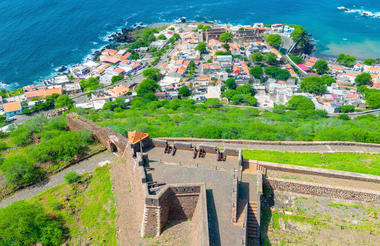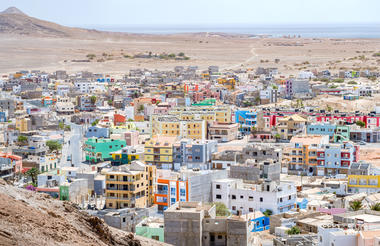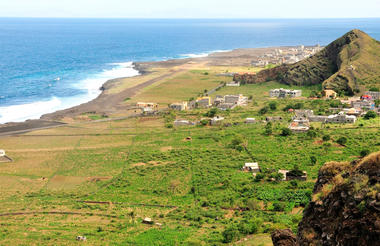Sunday, April 16
Arrive in Lisbon
Having made your way to Lisbon, you will be met by a representative of Aurora Expeditions and transferred to our group hotel.
This evening, enjoy a light refreshment as you meet your fellow expeditioners at a Welcome Reception and Pre-Embarkation Briefing. Afterwards, dine at your leisure (dinner not included).



Monday, April 17
Embarkation
Final, mandatory pre-embarkation health screening and COVID (rapid antigen) testing will be completed before transferring to the airport for our charter flight to Praia, Cape Verde.
After arriving in Praia and if time allows, we enjoy some of Praia’s main sites, including a visit to the old town of Cidade Velha, the former capital of Cape Verde and now a UNESCO World Heritage Site. The views of the town from the fortifications of Forte Real de São Filipe are sublime.
In town, we might visit Igreja de Nossa Senhora do Rosário,a church dating back to 1495, which was visited by explorers Vasco da Gama and Christopher Columbus who stopped in Praia soon after the church was built. A marble whipping post in the town square is a bleak reminder of
the many people who were brought to Cape Verde from mainland Africa to be traded as slaves.
Transfer to the port for embarkation and settle into your cabin before attending important safety briefings.
Enjoy the thrill of departure as we ‘throw the lines’ and set sail.
This evening, get to know your fellow expeditioners and our friendly Expedition Team and crew at the Captain’s
Welcome Dinner, to celebrate the start of a thrilling adventure.



Tuesday, April 18
Fogo Island, Cape Verde
Zodiacs shuttle us ashore at the port of São Filipe where we begin our exploration of Fogo Island, also known as the ‘black pearl’ of Cape Verde for its black volcanic sand. Wander the cobbled streets of São Filipe, a colorful Portuguese colonial town, exploring the vibrant market and local museum.
Leaving the charming town, we drive along serpentine roads that take us higher and higher towards the entrance to Parque Natural do Fogo, where the Fogo volcano is located. At 2,828 meters (9,281 feet), the volcano is the highest point in the Cape Verde Islands.
Fogo Island is a single, massive active stratovolcano that last erupted in 2014. Fogo is Portuguese for ‘fire.’ The dramatic landscape of Fogo has been shaped by centuries of volcanic activity, leaving a landscape of collapsed calderas, lava fields and craters.



Wednesday, April 19
Boa Vista Island, Cape Verde
Boa Vista is the most easterly island in the archipelago. Marine turtles, extensive sand dunes and 55 kilometers (34 miles) of beaches, and traditional music, are the island’s main attractions. Between January and May, small pods of humpback whales visit Cape Verde to breed and give birth to live young, and Boa Vista is one of the best places to see them.
Sal Rei is the capital of Boa Vista Island. It is a quiet, sleepy town with its charming palm-filled main square, Praça da Santa, brimming with flowers and pavilions. The Santa Isabel church is located in the square and features the graves of the Jewish Ben’Oliel family, who fled persecution in Morocco in the 1800s. After exploring the town square, perhaps enjoy a stroll along the Avenida dos Pescadores (Fishermen’s Avenue), which runs along the waterfront or
perhaps explore the old harbor and the boatyard.



Thursday, April 20
Santo Antão, Cape Verde
In Santo Antão, we disembark at Porto Novo to begin our exploration of this mountainous island and its sensational landscapes. We drive north into the island’s steep mountainous interior cut by deep, rocky ravines and venture into verdant forests, stopping to view an old volcanic caldera, Cova de Paúl. We pass through small hamlets clinging to the sides of hills, where locals roast their own blend of coffee, filling the air with its distinct aroma.
Santo Antão’s ‘ribeiras’ – deep, narrow canyons with near-vertical walls – are one of the island’s most impressive features. Our exploration of the island includes a walk among lush farming valleys where breadfruit, bananas, papaya and sugar cane grow. You may also have a chance to taste grogue, Cape Verde’s national drink made from sugar cane.



Friday, April 21
At Sea
As we sail north to the Canary Islands, enjoy informative and entertaining lectures from our Expedition Team, who may presents talk on various ‘ologies’, including volcanic geology, marine biology or ornithology, and cultural geography.
You may choose to spend your time editing photos of Cape Verde or simply enjoying the many wonderful facilities on the ship.



Saturday, April 22
At Sea
As we sail north to the Canary Islands, enjoy informative and entertaining lectures from our Expedition Team, who may presents talk on various ‘ologies’, including volcanic geology, marine biology or ornithology, and cultural geography.
You may choose to spend your time editing photos of Cape Verde or simply enjoying the many wonderful facilities on the ship.
Sunday, April 23
El Hierro, Canary Islands
El Hierro is the smallest and most south westerly of the Canary Islands and is located below La Palma. The island is famous for its volcanic landscape, remarkable rock formations and diverse flora. The spectacular marine life attracts scuba divers and snorkelers from around the world. UNESCO has classified El Hierro Biosphere Reserve as part of the Man and the Biosphere Programme.
Departing from the tiny harbor town of La Estaca, we begin our ascent to El Hierro’s small, quiet capital, Valverde, meaning ‘the green valley’. Valverde is the only capital in the Canary Islands that is not located on the coast. Enjoy a walk through the town where no building is more than two storeys high and where there are no traffic lights.
Perhaps stop to visit the beautiful 18th-century church Nuestra Señora de La Concepción. Afterwards, we continue our climb and stop at Jinama lookout. At 1,300 metres (4,265 feet) above sea level, the view of El Golfo Valley is simply spectacular. On our descent, we drive to the small village of Frontera, passing lush valleys along the way where pineapple, banana, papaya and mango are grown.
El Hierro is home to the El Hierro giant lizard. With a broad head, dark, robust body and long tail, the indigenous giant lizard can measure up to 60 centimetres (24 inches) and has long been an emblem of El Hierro, where it lives on the island’s rocky, arid terrain. The giant lizard is close to extinction and is now protected by international law.
The Centre for the Recovery of the El Hierro Giant Lizard, also known as Lagartario, is a research Centre that studies the giant lizard and runs breeding programs to boost numbers. We visit the Centre to see these enigmatic creatures and to learn about the conservation efforts to protect them.
At La Peña lookout, you have the opportunity to sample some local cheeses and wines while enjoying magnificent views of El Hierro’s north coast.



Monday, April 24
La Gomera, Canary Islands
The island of La Gomera, shaped like a near-perfect circle, is the second smallest of the Canary Islands. San Sebastian, the capital of the island is a picturesque village and harbor. The town is best explored on foot. Enjoy an easy stroll along the main street of the Old Town, Calle Real, where the stunning church, Iglesia de la Virgen de la Asunción, is located. It was here that Columbus and his crew attended mass after loading his ships with supplies and water before setting sail for America. Today, the church is still used by crew to pray for safe passage before they depart on voyages. You will also have an opportunity to visit the church at the end of the day.
Today’s adventures will focus on the scenic north side of La Gomera Island and the beautiful national park, where you will learn about the local flora and fauna. Enjoy a short and easy guided walk through one of the oldest laurel forests in the world; a prehistoric ecosystem that has survived as a result of the island’s temperate climate. The area became a national park in 1981, and a UNESCO World Heritage Site in 1986.
Continue our drive to Hermigua, a beautiful, verdant valley known for its mild climate, water-filled ravines, and banana plantations. Here you can visit a handicraft center and see displays of local pottery, utensils and looms, giving you an insight into how locals used to live. We continue our panoramic drive to the village of Agulo to visit the Juego de Bolas (Garajonay National Park Visitor Centre), which has outstanding exhibitions on the geology, climate, flora and fauna of the park. The ‘House of Memory’ has fascinating exhibits of traditional island culture including the
interior of a rural house, farming equipment a cellar and traditional ceramics.
Back in town, you can visit Iglesia de la Virgen de la Asunción, as well as the 15th-century fortress Torre del Conde, and the La Gomera Archaeological Museum.



Tuesday, April 25
At Sea
Our onboard lecture series continues with fascinating talks on the people, history and culture of the islands visited on our voyage as well as presentations on wildlife and geology. You may choose to spend your time keeping fit in the gym, or treating yourself to a massage in the wellness center.
Wednesday, April 26
At Sea
Our onboard lecture series continues with fascinating talks on the people, history and culture of the islands visited on our voyage as well as presentations on wildlife and geology. You may choose to spend your time keeping fit in the gym, or treating yourself to a massage in the wellness center.
Thursday, April 27
Flores, Azores
Located in the middle of the Atlantic Ocean, the archipelago of the Azores is where three continental plates meet. It is an area that attracts large numbers of whales and adventurous sailors. Dr Sylvia Earle’s Mission Blue recognises the Azores archipelago as a Hope Spot and says, ‘The Azores archipelago is a magnet for life. It really is a magical place. Launching the Azores as Hope Spot is so logical – just ask the whales. They know how special this place is. This
used to be a place where whales were killed, and now people are making a living by respecting the whales and having people come out and visit them as fellow citizens of the planet.’
Not only is the Azores archipelago a Mission Blue Hope Spot, many of its islands are recognized by UNESCO as places of universal value.
In 2009, Flores was classified as a UNESCO Biosphere Reserve. The island offers a number of sublime walking trails where you can choose to follow the coastline or venture inland to see shimmering lakes of flooded volcanic calderas.
There are countless waterfalls and birders can expect to see migratory species including waders, passerines, shearwaters and terns.
Flores also features some splendid Portuguese architecture including the 19th-century church Nossa Senhora da Conceição, and the Flores Museum.



Friday, April 28
Graciosa, Azores
The small and lush island of Graciosa awaits with adventures of a visit to Furna do Enxofre, where we descend by spiral staircase into a 100-metre (328-foot) deep cavern beneath the plug of a former volcano. This well-known volcanic feature still exudes fumes and has bubbling mud pools.
In 2007, Graciosa was classified as a UNESCO Biosphere Reserve. The Azores are internationally recognized as a spectacular destination for birdwatching. The archipelago boasts approximately 30 breeding species, with the number of occasionally seen species already approaching 400, and Graciosa is home to a number of endemic species, including Monteiro’s storm petrel.
Graciosa offers wonderful walking trails including coastal hikes and a walk along the perimeter of the volcanic cone.
Other popular activities offered on the island are excursions for whale watching and swimming with dolphins.



Saturday, April 29
Terceira, Azores
Terceira Island is renowned for its rich historical heritage. The city of Angra do Heroismo is classified as a World Heritage Site by UNESCO. A walking tour of Angro do Heroismo includes a visit to the small but stunning botanical gardens, the town’s main cathedral and the delightful town square. You may choose to visit Algar do Carvão, a volcanic cave showcasing magnificent stalactites and stalagmites of amorphous silica, where the upper walls are covered in ferns, mosses and liverworts.
The island offers superb birdwatching and is home to a colony of common terns and roseate terns nesting in a special protected area. It is also possible to spot waders from North America here. Excursions for whale watching and swimming with dolphins are also available on Terceira Island.



Sunday, April 30
Ponta Delgada, Azores
Disembark in Ponta Delgada, where a charter flight awaits to transport us back to Lisbon. Flight times are yet to be confirmed and if time allows, we will explore some of São Miguel Island’s attractions. São Miguel features a number of delightful gardens to explore including the António Borges Garden, named after the greatest Azorean landscape architect, and the José do Canto Botanical Garden, which has collections of rare plants. Terra Nostra Park features a thermal swimming pool and more than 2,000 trees, and Ponta da Ferraria is a spa and bathing site with therapeutic springs that have been used since the 15th century. All are fantastic options to enjoy before transferring to the airport for our charter flight to Lisbon.








